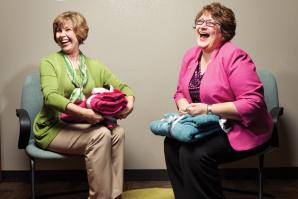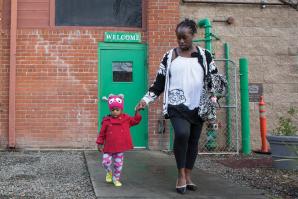After two decades of working in the nonprofit industry, Robin Chronister, an executive assistant for Mother Lode Rehabilitation in Placerville, noticed a gradual but clear change in the nonprofit sector. Due to the struggling economy, donors had less money to give but were demanding greater accountability and transparency from the organizations they supported before agreeing to loosen their purse strings. The message was clear for Chronister: Enter a new era, or fail.
“The traditional approach to fundraising and securing donor dollars no longer worked as effectively as it used to,” Chronister says. “We needed to become more professional and businesslike in our approach.”
In the past, as many as 90 percent of donors gave to organizations based purely on emotions, with no research behind their giving. Today, that still defines approximately 65 percent of donors, but the number is shrinking and the percentage of those asking for more accountability is increasing.
“It used to be easier to appeal to a donor’s emotions,” says Chronister. “Now, donors are treating their donation more like a business investment. They want to see the specifics.” That means demonstrating the cost of a program, how it’s used and its impacts and then communicating that information effectively to donors. A general understanding of business, social media, accounting and marketing principles is imperative.
To get up to speed on the changing dynamics, Chronister enrolled in the Nonprofit Organization Management program (NPOM) at Folsom Lake College while concurrently studying for her business and management degrees.
“Even with as much experience and knowledge as I had, every time I learned something new, I was faced with a situation where I was able to apply it,” she says. “I’ve learned a lot about leadership and management and how to communicate effectively with donors. I have also learned how to successfully share my passion for the organization I work for.”
Chronister is part of a growing trend focused on educating
nonprofit staff and the next generation of philanthropists. Now
considered serious academic pursuits, the study and teaching of
philanthropy and nonprofit management is hitting mainstream
education nationwide and locally.
The incoming generation of philanthropists is mostly young,
technologically savvy and accustomed to information-based
outcomes, but they often lack donor experience. Many initially
became interested in philanthropy by volunteering.
“Volunteering is one of the key onramps for getting young people engaged in philanthropy,” says Dr. David Hosley, a former Stanford professor and general manager of KVIE Public Television. A veteran in the nonprofit sector and a pioneer in philanthropy education, Hosley was one of the first to teach a nonprofit course at the college level.
“The earlier someone is exposed to the idea of using their time and resources in a way that is meaningful, the more likely they are to be engaged in that process throughout their lifetime,” Hosley says.
Students drawn to academic programs in nonprofit studies are typically looking for a way to parlay their passion for helping others into a career. Academic institutions are responding, developing academic programs in philanthropy and nonprofit management that offer students a specific career pathway and meet nonprofits’ demand for more trained professionals.
One of the earliest to get on board, Indiana University created the nation’s first school of philanthropy in 2010, a sign of the demand for rigorous training from people who work at charitable institutions. Last May, the university graduated its first students with bachelor’s degrees in philanthropy.
Other universities have followed suit. Pepperdine University now offers a master’s in social entrepreneurship, while Sonoma State University offers a master’s in public administration with a concentration in nonprofit management. Students at the University of San Francisco can take nonprofit and philanthropy courses through the Graduate Program for Urban Affairs, and at Stockton-based University of the Pacific, classes on nonprofit board training are offered through the business school.
Locally, Folsom Lake College offers a Nonprofit Organization Management Certificate of Achievement, the program Chronister chose. It gives students the opportunity to learn about nonprofit organizations, with an emphasis on nonprofits in the Capital Region. The goal is to produce trained professionals who can blend solid business practices and skills with techniques specific to the sector.
“Nonprofits are becoming more sophisticated, more discerning in who they hire,” says Gary Hartley, dean of instruction and technology at Folsom Lake College. “They want someone who is well educated and prepared to help them employ solid business practices in pursuit of community-based solutions to the many challenges our region faces.”
Up and running since fall of 2011, the NPOM program combines nonprofit courses on fundraising and governance with business, marketing and management classes. Students learn specific, marketable skills, like how to articulate the different financial challenges facing nonprofits, how to build and critique a governing board and how to best use technology and business tactics to accomplish a nonprofit’s mission.
“All of these learning outcomes ultimately help a student effectively demonstrate more accurate ROI for a donor,” Hartley says.
Another pathway for connecting students and nonprofits is through partner-based programs such as the one offered through the Kansas City-based Nonprofit Leadership Alliance (NLA).
NLA partners with colleges, universities and nonprofits to strengthen the leadership of the nonprofit sector through education and experiential training. Offered at a number of college and university campuses throughout the country, students can earn a Certified Nonprofit Professional credential through the program, which teaches nonprofit competencies through traditional academic coursework, internships, leadership and service-learning projects.
“Our main directive is to provide the nonprofit sector with a prepared and talented workforce that can hit the ground running and make an immediate impact,” says NLA Director of Marketing Christa Beall Diefenbach. “Our research shows that students who complete our program are better prepared to enter the workforce and are able to reduce the initial learning curve by as much as two years. That’s a significant amount of time and can offer a real advantage to both the student and the organization they work for.”
Through the NLA program, students also have the option to participate in the AmeriCorps National Civilian Community Corps. Similar to the Peace Corps, but specific to supporting nonprofits and public agencies, AmeriCorps NCCC is a team-based residential community service program for 18 to 24 year olds. The Pacific Region campus is based right here in Sacramento. Team members work with local communities for 10 months to address pressing needs. Sacramento teams have worked with the Sacramento Food Bank and Family Services, Loaves & Fishes and the city of Sacramento, among others.
“The more this kind of information is made available through easily accessible channels, the more opportunity we have to get people engaged at all levels and help them understand the important role philanthropy plays in the community,” Hosley says.
He testifies to the socioeconomic value of philanthropy-focused education and has been witness to a continuum of learning through his own students. In the ’90s Hosley taught a course in the Stanford Graduate School of Business called “Strategic Management in the Nonprofit Environment.” It covered topics like how to head a nonprofit organization and the roles of leadership.
“Most of the students who took the course ended up initially working for companies in the private sector but became board members of local nonprofits,” Hosley says. “Eventually, several of those same students migrated to the nonprofit sector and continued their careers there.”
One of those students was Laura Arrillaga-Andreessen, the popular author, philanthropist and now Stanford professor who kick-started a movement of helping the next generation of philanthropists become more strategic.
Operating as a philanthropic innovation lab, the Laura Arrillaga- Andreessen Foundation uses technology to offer philanthropy education that advances the field and increases its impact. Recently, Arrillaga-Andreessen posted all 13 years of her philanthropy teaching resources free of charge on her foundation website to assist educators in successfully creating and teaching their own philanthropy courses.
In releasing the materials, Arrillaga- Andreessen indicated she’s using technology to break down the physical barriers of college campuses and make the intellectual capital of the educator community available to anyone committed to learning.
“Laura has the right idea with this philosophy,” Hosley says. “We want to lift all boats. Sharing the benefit of our collective knowledge ultimately benefits the entire sector and strengthens our communities.”
Recommended For You

Expanding a Vision
New leadership means fresh ideas for Women in Philanthropy
Banning together 12 years ago, a group of local women sought out to help foster youth establish healthy lives after emancipation.

Under One Roof
Can rapid rehousing save local homeless families from life on the streets and in shelters?
Though a new rapid rehousing initiative may stymy the troubling trend locally, some providers remain concerned that a lack of mandatory supportive services and intensive case management may cause the program to exacerbate, not eliminate, the problem.




Comments
What a great article, my daughter Lynn Carvalho has started a non-profit SNiP in Vallejo. for the purpose of spaying and neutering animals in Vallejo.
Just today she was complaining about volunteers who offer to help, then question what she wants done....
Having access to a person who has been taught the basis of getting donations would be a "God send".
Found out about your magazine yesterday while watching TV, Winnie is a great inspiration.
Thank you,